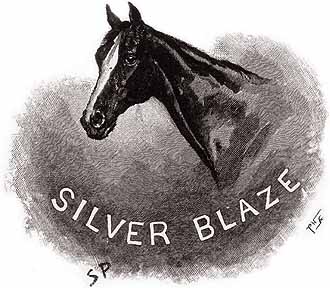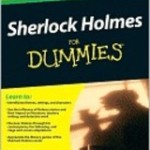A Scion Society of The Baker Street Irregulars

Data! Data! Data! – The Silver Blaze
“‘Data! Data! Data!‘ he cried impatiently. ‘I can’t make bricks without clay.’”
– The Adventures of The Copper Beeches (COPP)

This column is composed of material (Data!) developed for a short course called Appreciating Sherlock Holmes that I teach twice a year in the Community Education Life Enrichment Program for a local community college. It is composed of “points of information” that are common to many / most / all of the 60 Canonical stories.
The information here has been researched by me or borrowed / stolen from many efforts of other Sherlockians.
HERE GOES This month’s story…… Silver Blaze
 CHRISTOPHER MORLEY SAID . . .
CHRISTOPHER MORLEY SAID . . .
This fine story, which shows Holmes at the top of his form, involves various problems of ethics. The crime was caused by a woman’s excessive taste for expensive clothes, yet the actual murdered was not human, and all concerned (including Holmes) might have been prosecuted as accomplices in crooked gambling.
DUMMIES SHORT SUMMARY (From Sherlock Holmes for Dummies by Steven Doyle & David Crowder)
“An investigation into a stolen racehorse and a murdered trainer leads to a surprising suspect!”
PUBLISHING HISTORY
- This is the 15th of the 60 stories published
- In England, it was first published in The Strand Magazine in December, 1892
- In the United States it was first published in Harper’s Weekly on February 25, 1893
- It is part of The Memoirs of Sherlock Holmes collection published by George Newnes, Ltd., London, 1894 and by Harper Bros., New York, 1894
- The British illustrator was Sidney Paget and in the United States. it was W. H. Hyde
HOW MANY WORDS?
According to C. E. Lauderback, 1960 – – found on SHERLOCKIAN.NET website of Chris Redmond, at 9,650 words SILV has the 43rd most words (#1 is VEIL – 4,499, #56 if NAVL – 12,701)
THE BEST OF SHERLOCK HOLMES (How do Sherlockians rate this story?)
- 1927 – Arthur Conan Doyle did not on his list of 12 favorites
- 1944 – The Baker Street Irregulars voted it as #4 on their top 12 favorites
- 1959 – The Baker Street Irregulars votes it #4 on list of 10
- 1999 – The Sherlock Holmes Society of London ranked it 5th of the 56 short stories
CLASSIFYING THE CASE (From the Wandering Gipsies of Grimpen Mire of Decatur, Alabama)
This case is one of 23 classified as a MURDER and one of 14 where the perpetrator was either killed, arrested, or otherwise satisfactorily handled. And the victim was killed by a horse.
CHRONOLOGICALLY SPEAKING
Doyle was often very vague about stating WHEN the tale took place and included few contemporary references to help. Whether this was done intentionally or unthinkingly, the dating of events in the Canon is a very popular pastime pursued by several of our “scholars” researching and justifying their results to no end. We will again default to William Baring-Gould’s dating of Thursday, September 25 to Tuesday, September 30, 1890 making it 29th of the 60 stories in time. This means that Holmes was 36 and Watson 38.
WHAT ELSE HAPPENED IN YEAR 1890?
It is always interesting to see what else in happening at the same time as the stories
- Work of Rhodes Pioneers begun in Southern Rhodesia.
- Britain annexes Uganda.
- Britain recognizes French Protectorate over Madagascar.
- Omnibus strike in London settled on basis of 12-hour day.
- London-Paris telephone line opened.
- Financial panic in London and in Paris.
- Lunacy Act gives management of asylums to visiting committees.
- Booth writes, In Darkest England.
- German control over East African territories.
- Wounded Knee massacre.
- Idaho and Wyoming are admitted into the Union.
- Workmen in France allowed compensation for contracts broken by employers.
- William III of Holland dies; Luxembourg passes to Duke of Nassau.
- Fall of Bismarck; Caprivi made Imperial Chancellor; start of personal rule of William II.
- First meeting of Japanese Legislature under new Constitution.
- In Chicago, the first entirely steel-framed building erected.
- First Chinese cotton mill constructed.
- Degas paints Dancers in Blue.
- Prince Igor, commenced by Borodin (dies 1887), completed by Glazunov and Rimsky-Korsakov.
- Ibsen writes, Hedda Gabler.
- Emil von Behring, German bacteriologist, discovers immunity to tetanus can be given by use of serum; introduces name “antitoxin.”
- Halsted, at John Hopkins Hospital, first to use rubber gloves in surgery.
- Moving-picture films, precursor of cinematography (q.v., 1894) shown in New York.
- Cyanide process of preparation of gold from crude ore developed in South Africa (q.v., 1887).
- Discovery of Cleopatra’s tomb.
HOLMES AND WATSON – PERSONAL INFO
1890 has Holmes and Watson firmly entrenched in Baker Street.
DRAMATIS PERSONAE
- JOHN STRAKER, an ex jockey turned trainer. He trained Silver Blaze
- ROSS, owner of Silver Blaze.
- FITZROY SIMPSON, a neighbor of the Colonel who liked to bet on the horses.
- LORD BACKWATER, owner of a training stable across the moor from the Colonel.
- SILAS BROWN, trainer for Lord Backwater.
- EDITH BAXTER, maid to Straker. She delivered the curried mutton to Ned.
- NED HUNTER, groom on guard duty when Silver Blaze was stolen.
- INSPECTOR GREGORY, a competent local officer.
- SILVER BLAZE, prize winning horse.
- THE DOG, who didn’t do anything
“QUOTABLE SHERLOCK”
Everything quotable in this story comes from the Master.
- “We are going well,” said he, looking out the window and glancing at his watch. “Our rate at present is fifty-three and a half miles per hour.”
- “I have not observed the quarter mile posts,” said I.
- “Nor have I. But the telegraph posts upon this line are sixty yards apart, and the calculation is a simple one.”
- “It is one of those cases where the art of the reasoner should be used rather for the sifting of details than for the acquiring of fresh evidence.”
- “Nothing clears up a case so much as stating it to another person.”
- “Inspector Gregory, to whom the case has been committed, is an extremely competent officer. Were he but gifted with imagination he might rise to great heights in his profession.”
- “That is the case as it appears to the police, and improbable as it is, all other explanations are more improbable still.”
- “See the value of imagination,” said Holmes. “It is the one quality which Gregory lacks. We imagined what might have happened, acted upon the supposition, and find ourselves justified.”
- “I follow my own methods and tell as much or as little as I choose. That is the advantage of being unofficial.”
- Holmes and Watson discussing how he reached conclusion
- “Is there any point to which you would draw my attention?
- To the curious incident of the dog in the night-time
- The dog did nothing in the night-time.
- That was the curious incident?”
- “One true inference invariably suggests others.”
HOLMES’ FEE
No mention, although Col. Ross did acknowledge he was under obligation to Holmes. Holmes had also made a bet on the next race and stood to win a little. It is possible he was helped with a little inside information.
SHERLOCK ON THE BIG SCREEN & THE LITTLE SCREEN
- 1923 Silver Blaze with Eille Norwood. The National Film and Television Archive at the BFI has viewing copies of this film but it has not been released

- 1937 Silver Blaze with Arthur Wontner in one of his four theatriucal features with Holmes
- 1977 Dark and Dangerous: Silver Blaze with Christopher Plummer in a TV Movie as part of short mystery/horror series.
- 1988 Silver Blaze with Jeremy Brett as the 23rd story in the Granada / BBC series
- 2000 Silver Blaze in the Sherlock Holmes in the 22nd Century animated TV series
SHERLOCK HOLMES IN DISGUISE
The Master of disguise used the deception of being disguised 14 times in 11 of the 60 stories. No one, however, uses a disguise in this one.
UNRECORDED CASES (That involved Holmes)
Watson would tease / torture his readers with “I know something you don’t.” Oh my, how Sherlockians love this category. I have in excess of over 150 examples in my collection.
Neither Watson no Holmes discussed any unrecorded cases in this tale.
IS THERE A DOCTOR IN THE HOUSE?
Victorian London, in the Holmes’ time, had approximately 1 doctor for every 100 people. 31 of the 60 tales have a doctor in them. This, of course, does not count Holmes’ Boswell. This listing is by Leslie Klinger in the Winter, 2015 edition of the Baker Street Journal. Whether it was Doyle or Watson, a doctor wrote the story. In this story there was no doctor involved or mentioned.
FAINTING IN THE CANON (courtesy of Sherlockian Karen Murdock)
Fainting is extremely common in the Canon, appearing, in some form, in 37 of the 60 tales. In 21 cases someone actually faints. In 22 cases someone almost faints. And in 5 cases someone pretends to faint. In this month’s tale, Silas Brown almost faints.
HOLMES’S PUBLISHED & PROJECTED WORKS
Sherlockians love this topic and are regularly searching for these items. Holmes mentions published or projected works in 11 of the stories. This story, however, forgoes newspapers.
NEWSPAPERS (Real and Fictional)
Though included in only 20 tales, some of our more obsessed Sherlockians love this one. This tale mentions the Daily Chronicle, a morning paper established in 1877 which was liberal and one of the most popular.
ANNOTATED SHERLOCK
The 60 Sherlock Holmes stories used English as spoken in England from the 1880’s until the 1910’s. Some words are foreign to us today and need a “contemporary translation.”
- “vestas” A vesta is a friction match, so named for the Roman goddess of the hearth and fire.
- “Cavendish” A kind of smoking tobacco softened and pressed into solid cakes, and so called from the name of the maker.
- “a drag” A private stagecoach with seats inside and on top.
- “his ear-flapped traveling cap” This and the reference in BOSC to a “close-fitting cloth cap” are the only references to the “deerstalker” which Sidney Paget depicted Holmes and which became his trademark. The HOUN also refers to a cloth cap but Paget drew a homburg.
- “touts” A agent who obtains and sells information on the condition and prospects of horses entered for an upcoming race.
- “Penang lawyer” A walking stick with a large round head and imported from Penang, an island off the west coast of Malaya. Origin of “lawyer” part is debatable. Could refer to “fire-dried” process in manufacturing or its being used to settle legal maters.
- the “boss” of a shield The convex projection in the center.
- “landau” A four-wheeled carriage with a top in two parts so that it may be closed, half-open, or entirely open.
- “spirits of wine” brandy
- the horses “ham” The area behind the knee
- “furze-bush” it’s just another name for gorse. (I thought there may have been a botanical difference, but apparently not – and “whin” is just another name for the same plant.) In case you’re not familiar with gorse, the bushes have extremely nasty spikes instead of leaves, and yellow flowers. (They’re quite attractive in a rugged moorland sort of way — en masse and from a distance.)
WEAPONS (from A Compendium of Canonical Weaponry by Dettman and Bedford)
… “a means by which one contends against another” … utilized in 57 of the 60 tales (all but CREE, 3STU, & YELL) There are several general categories to classify “weapons” that include: firearms, human agents, cutlery, animals, blunt instruments, extortion, toxin, blackmail, and miscellaneous. In our story, which is short, you will find all of the following:
- Small Surgeon’s Knife – Which John Straker used in an attempt to cripple Silver Blaze, Col. Ross’s prized race horse
- Heavy, Bulbous-Headed Cane – Of Fitzroy Simmons, weighted with lead at the end, which Inspector Gregory thought Simpson used to murder John Straker.
- Opium – Mixed with curried mutton, which John Straker used to dope the stable boy, Ned Hunter.
- Dog – Which Silas Browne threatened to set on Holmes and Watson.
- Watch Dog – At King’s Pyland, which was set on Fitzroy Simpson, and which later gained eternal fame for doing nothing in the nighttime.
- Threat – Used by Holmes on Silas Brown, implicating the latter in the illegal possession of Silver Blaze.
ODD STUFF
Arthur Ignatius Conan Doyle took a considerable amount of criticism for Silver Blaze about not knowing “squat” about the sport of Horse racing. Near the end of his career Doyle addressed the issue in 1923 in his autobiography Memories and Adventures.
Sometimes I have got upon dangerous ground where I have taken risks, through my own want of knowledge of the correct atmosphere. I have, for example, never been a racing man, and yet I ventured to write “Silver Blaze”, in which the mystery depends upon the laws of training and racing. … [In that story] my ignorance [of those laws] cries aloud to heaven. I read an excellent and damaging criticism of the story in some sporting paper, written clearly by a man who /did/know, in which he explained the exact penalties which would have come upon every one concerned if they had acted as I described. Half would have been in jail and the other half warned off the turf forever.
 Frank Mentzel, aka Merridew of Abominable Memory, is looking forward to attending the upcoming Scintillation of Scions X. When not ordering more books about Sherlock Holmes, he can be found outside working in his gardens and yard.
Frank Mentzel, aka Merridew of Abominable Memory, is looking forward to attending the upcoming Scintillation of Scions X. When not ordering more books about Sherlock Holmes, he can be found outside working in his gardens and yard.

Sorry, comments are closed for this post.